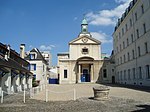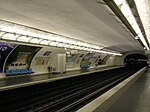Daumesnil (Paris Métro)

Daumesnil (French pronunciation: [domenil]) is a station on lines 6 and 8 of the Paris Métro in the 12th arrondissement. The station opened on 1 March 1909 with the opening of the original section of line 6 from Place d'Italie to Nation (although part of line 5—some dating back to 2 October 1900—was incorporated into line 6 on 12 October 1942). The line 8 platforms opened on 5 May 1931 with the extension of the line from Richelieu - Drouot to Porte de Charenton. It is named after the Avenue Daumesnil, which honours General Pierre Yrieix Daumesnil (1776–1832) who lost a leg at the Battle of Wagram. This station is near the Place Félix Éboué and its name plates refer to Félix Éboué (1884–1944), who brought Chad over to the Free French Forces in 1940, and as a result was made Governor General of French Equatorial Africa. It was the location of the Barrière de Reuilly, a gate built for the collection of taxation as part of the Wall of the Farmers-General; the gate was built between 1784 and 1788 and demolished in the nineteenth century.Nearby is the Promenade Plantée—a 4.5 km long elevated garden along the abandoned railway which led to the former Gare de La Bastille railway station.
Excerpt from the Wikipedia article Daumesnil (Paris Métro) (License: CC BY-SA 3.0, Authors, Images).Daumesnil (Paris Métro)
Place Félix Éboué, Paris 12th Arrondissement (Paris)
Geographical coordinates (GPS) Address Nearby Places Show on map
Geographical coordinates (GPS)
| Latitude | Longitude |
|---|---|
| N 48.839644 ° | E 2.395792 ° |
Address
Fontaine du Château d'eau
Place Félix Éboué
75012 Paris, 12th Arrondissement (Paris)
Ile-de-France, France
Open on Google Maps









